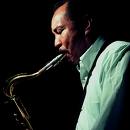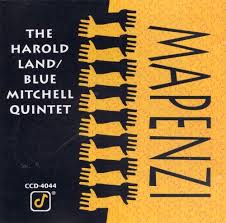Tres Senderos – Harold Land
An intricate Latin song whose form contains open-ended vamps in the middle of the head. Though these open sections are all on one chord, the song has no single key center. On the recording, the horns play fills over these vamp sections; a horn interplay transcription is available for both in and out heads.
- Recording: Harold Land - Mapenzi
- Recorded on: April 14, 1977
- Label: Concord (CJ 44)
- Concert Key: No key center
- Vocal Range: , to
- Style: Latin (medium up)
- Trumpet - Blue Mitchell
- Tenor Sax - Harold Land
- Piano - Kirk Lightsey
- Bass - Reggie Johnson
- Drums - Albert "Tootie" Heath
Video
- Description
- Historical Notes
- Solos
- Piano Corner
- Bass Corner
- Drum Corner
- Guitar Corner
- Inside & Beyond
- Minus You
This fascinating medium-up Latin song has an unusual long form with several contrasting sections. The total length of the head form, however, is not fixed—the middle of the head contains two open vamps, each with the next melody section on cue. On the recording, the horns play fills on the vamp sections, which are all on B♭7sus with a funky two-measure bass ostinato. Click on the Inside & Beyond tab for more details about the fills.
There is so much variety in this great Harold Land composition that to fade out our audio clip within the melody would only confuse. We are putting in the entire melody in the clip: from the open-feel intro, into Latin to start the melody, then funky Latin, then swing, then back to Latin.
The head begins lyrically, in G major but using Gm7 to go to D major. The fifth measure starts a descending sequence of II-V7s which continues for three measures and is interrupted by the B♭7sus vamp as a deceptive resolution (from G♭7). After eight measures of the vamp with light horn fills, the B section melody is played over the vamp: a soaring four-measure phrase in half-note triplets, followed by horn fills which continue over the vamp for an indefinite number of measures. This B section happens twice, with the second time on cue; the next cue is for the C section, which continues the same vamp for a final eight measures with a melody like the B section but descending at the end. Next there's a D section which goes to swing; the melody is based on angular triplet pickups, over descending dominant 7♯9 chords for six measures. The final E section returns to the Latin groove and is more lyrical like the beginning, starting on D♭ major and ending with two measures each of Fmaj7 and D7(♯9).
The solo form is essentially that of the head; the vamp is not open-ended but kept at 16 measures for each chorus. Both the D and E sections swing on the solos.
About the arrangement: Second parts are available for the two-horn arrangement, which starts unison but has a bit of counterpoint in the E section, ending with harmonies in fourths. The Concert Condensed Score also shows the tender recorded rhythm section intro (with Kirk Lightsey's piano part transcribed), which beautifully sets up the melody. Reggie Johnson's bass really gives the intro a great open feel, starting with a double-whole-note feel followed by a 1-feel for the last four measures. Pianists and drummers should read the Concert Condensed Score, though pianists are welcome to come up with their own interpretation of the intro. Bassists can read the C bass clef lead sheet, which shows the bass figure for the vamp; however, if you want to play the intro as recorded, the condensed score also works for the bass with bass notes written in circles below the staff in both the intro and vamp section.
There is so much variety in this great Harold Land composition that to fade out our audio clip within the melody would only confuse. We are putting in the entire melody in the clip: from the open-feel intro, into Latin to start the melody, then funky Latin, then swing, then back to Latin.
The head begins lyrically, in G major but using Gm7 to go to D major. The fifth measure starts a descending sequence of II-V7s which continues for three measures and is interrupted by the B♭7sus vamp as a deceptive resolution (from G♭7). After eight measures of the vamp with light horn fills, the B section melody is played over the vamp: a soaring four-measure phrase in half-note triplets, followed by horn fills which continue over the vamp for an indefinite number of measures. This B section happens twice, with the second time on cue; the next cue is for the C section, which continues the same vamp for a final eight measures with a melody like the B section but descending at the end. Next there's a D section which goes to swing; the melody is based on angular triplet pickups, over descending dominant 7♯9 chords for six measures. The final E section returns to the Latin groove and is more lyrical like the beginning, starting on D♭ major and ending with two measures each of Fmaj7 and D7(♯9).
The solo form is essentially that of the head; the vamp is not open-ended but kept at 16 measures for each chorus. Both the D and E sections swing on the solos.
About the arrangement: Second parts are available for the two-horn arrangement, which starts unison but has a bit of counterpoint in the E section, ending with harmonies in fourths. The Concert Condensed Score also shows the tender recorded rhythm section intro (with Kirk Lightsey's piano part transcribed), which beautifully sets up the melody. Reggie Johnson's bass really gives the intro a great open feel, starting with a double-whole-note feel followed by a 1-feel for the last four measures. Pianists and drummers should read the Concert Condensed Score, though pianists are welcome to come up with their own interpretation of the intro. Bassists can read the C bass clef lead sheet, which shows the bass figure for the vamp; however, if you want to play the intro as recorded, the condensed score also works for the bass with bass notes written in circles below the staff in both the intro and vamp section.
The Spanish title means "three paths," which could refer to the three contrasting sections of the form: the A section, the vamp, and the D and E sections. Harold regularly performed this song but never recorded it again. Later in April 1977, Blue Mitchell recorded on an all-star quintet session, issued as "Stablemates: Best Of The West, Vol. 1," including Victor Feldman and drummer Dick Berk. A month before the "Mapenzi" session, bassist Reggie Johnson played on Kenny Burrell's album "Tin Tin Deo."
The two B sections of the head are within an open B♭7sus vamp, which starts in the eighth measure of A and continues all the way until D. These B sections are not a fixed length; after the first four measures of melody, the vamp is open for the horns to improvise. The B2 melody is on cue, and so is the next melody phrase at C. On the recording, B1 of the in head ends up 12 measures long, and B2 is 14 measures; the out head gets to 14 measures each for B1 and B2.
Our B♭ melody horn interplay edition is a transcription of Harold Land's tenor sax and Blue Mitchell's trumpet fills through the vamp sections on both the in and out heads. The fills actually start eight measures before B1, right when the vamp starts; for both heads, the transcription begins at the seventh measure of A and continues through the two B sections. In each section of fills, Harold begins and Blue answers; on the in head Blue starts his lines while Harold is holding his last note, but the out head has more overlap between the lines. The trumpet and tenor lines are transposed in their respective range; if you're playing this as recorded on trumpet and tenor, you don't need to transpose anything up or down an octave. When Harold's and Blue's lines intersect at B1 and B2 of the out head, they are each written on their own staff; otherwise, the lines are combined into a single staff.
Our B♭ melody horn interplay edition is a transcription of Harold Land's tenor sax and Blue Mitchell's trumpet fills through the vamp sections on both the in and out heads. The fills actually start eight measures before B1, right when the vamp starts; for both heads, the transcription begins at the seventh measure of A and continues through the two B sections. In each section of fills, Harold begins and Blue answers; on the in head Blue starts his lines while Harold is holding his last note, but the out head has more overlap between the lines. The trumpet and tenor lines are transposed in their respective range; if you're playing this as recorded on trumpet and tenor, you don't need to transpose anything up or down an octave. When Harold's and Blue's lines intersect at B1 and B2 of the out head, they are each written on their own staff; otherwise, the lines are combined into a single staff.
Related Songs
Email Send Tres Senderos to a friend
Send this page to a friend via email. Add your name or email in the first field. In the second, add one or more email addresses, separated by a comma.

Harold Land
February 18, 1928 – July 27, 2001
Many people only know of Harold Land as the great tenor saxophone soloist who made the classic quintet recordings with the Clifford Brown - Max Roach Quintet: Joy Spring, Daahoud, The Blues Walk and other classics—many of which are available from jazzleadsheets.com. Harold is far more than just a great tenor saxophonist sideman. Read more...
There was a problem.
...

